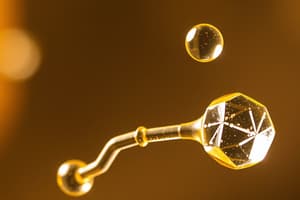Podcast
Questions and Answers
What is the primary source of vitamin D for humans?
What is the primary source of vitamin D for humans?
- Dietary sources
- Liver
- Kidney
- Skin synthesis (correct)
What is the function of 25-hydroxycholecalciferol in the liver?
What is the function of 25-hydroxycholecalciferol in the liver?
- Hydroxylation of cholecalciferol (correct)
- Regulation of calcium absorption
- Synthesis of vitamin D
- Storage of vitamin D
What is the main function of vitamin D in the body?
What is the main function of vitamin D in the body?
- Energy production
- Protein synthesis
- Antioxidant function
- Regulation of calcium absorption (correct)
What is the active form of vitamin D produced in the kidney?
What is the active form of vitamin D produced in the kidney?
What is the result of vitamin D deficiency in adults?
What is the result of vitamin D deficiency in adults?
What is the primary function of vitamin E?
What is the primary function of vitamin E?
What is the most active form of vitamin E?
What is the most active form of vitamin E?
What is the consequence of taking excessive vitamin D supplements?
What is the consequence of taking excessive vitamin D supplements?
What is biochemistry primarily concerned with?
What is biochemistry primarily concerned with?
Which nutrient category do vitamins fall under?
Which nutrient category do vitamins fall under?
How do vitamins typically function in biochemical processes?
How do vitamins typically function in biochemical processes?
What must be supplied by the diet since the body generally cannot synthesize them?
What must be supplied by the diet since the body generally cannot synthesize them?
Which of the following roles do vitamins NOT play in the body?
Which of the following roles do vitamins NOT play in the body?
What is the significance of vitamins in relation to enzymes?
What is the significance of vitamins in relation to enzymes?
What is the primary difference between water-soluble and fat-soluble vitamins?
What is the primary difference between water-soluble and fat-soluble vitamins?
Which of the following is NOT a function of vitamin A?
Which of the following is NOT a function of vitamin A?
What is the difference between retinoids and carotenoids?
What is the difference between retinoids and carotenoids?
Which of the following is a potential consequence of chronic vitamin A toxicity?
Which of the following is a potential consequence of chronic vitamin A toxicity?
What is the recommended upper limit of vitamin A intake for women who are pregnant or may become pregnant?
What is the recommended upper limit of vitamin A intake for women who are pregnant or may become pregnant?
Which of the following is a common sign of vitamin A deficiency?
Which of the following is a common sign of vitamin A deficiency?
What is the most important role of retinoic acid in the body?
What is the most important role of retinoic acid in the body?
What is the main difference between the treatment for water-soluble and fat-soluble vitamin deficiencies?
What is the main difference between the treatment for water-soluble and fat-soluble vitamin deficiencies?
Flashcards
What is Biochemistry?
What is Biochemistry?
The study of chemical reactions that occur within living organisms.
What are vitamins?
What are vitamins?
Organic nutrients needed in small amounts for various biochemical functions, they cannot be synthesized by the body.
How are vitamins classified?
How are vitamins classified?
Vitamins are classified based on their solubility: water-soluble or fat-soluble.
What are water-soluble vitamins?
What are water-soluble vitamins?
Signup and view all the flashcards
What are fat-soluble vitamins?
What are fat-soluble vitamins?
Signup and view all the flashcards
What are retinoids?
What are retinoids?
Signup and view all the flashcards
What are carotenoids?
What are carotenoids?
Signup and view all the flashcards
What are the functions of vitamin A?
What are the functions of vitamin A?
Signup and view all the flashcards
What are the symptoms of Vitamin A toxicity?
What are the symptoms of Vitamin A toxicity?
Signup and view all the flashcards
What are the symptoms of Vitamin A deficiency?
What are the symptoms of Vitamin A deficiency?
Signup and view all the flashcards
What is unique about vitamin D?
What is unique about vitamin D?
Signup and view all the flashcards
What are the forms of Vitamin D?
What are the forms of Vitamin D?
Signup and view all the flashcards
What are sources of Vitamin D?
What are sources of Vitamin D?
Signup and view all the flashcards
What is the main function of vitamin D?
What is the main function of vitamin D?
Signup and view all the flashcards
What are the symptoms of Vitamin D deficiency?
What are the symptoms of Vitamin D deficiency?
Signup and view all the flashcards
What are the symptoms of Vitamin D toxicity?
What are the symptoms of Vitamin D toxicity?
Signup and view all the flashcards
What are the forms of vitamin E?
What are the forms of vitamin E?
Signup and view all the flashcards
What is the function of vitamin E?
What is the function of vitamin E?
Signup and view all the flashcards
How does vitamin E protect the body?
How does vitamin E protect the body?
Signup and view all the flashcards
Study Notes
Biochemistry
- Biochemistry is the science concerned with the study of chemical reactions that occur in living organisms.
Vitamins
- Vitamins are organic nutrients required in small quantities for various biochemical functions and cannot be synthesized in the body.
- Vitamins assist in the formation of hormones, blood vessels, nervous system chemicals, and genetic materials.
- Vitamins act as catalysts, combining with proteins to create metabolically active enzymes essential for life reactions.
Classification of Vitamins
- Vitamins can be classified into water-soluble and fat-soluble vitamins.
Water-Soluble vs Fat-Soluble Vitamins
- Water-soluble vitamins:
- Are soluble in water
- Are absorbed simply
- Are not stored in the body
- Are excreted
- Excess intake is non-toxic
- Deficiency manifests rapidly
- Treatment involves regular dietary supply
- Fat-soluble vitamins:
- Are soluble in fat
- Are absorbed along with lipids
- Are stored in the liver
- Are not excreted
- Excess intake is toxic
- Deficiency manifests slowly
- Treatment involves a single large dose
Fat-Soluble Vitamins: Vitamin A
- Vitamin A occurs in two forms in food: retinoids and carotenoids.
- Retinoids are preformed vitamin A found only in foods of animal origin.
- Carotenoids are found in plants, comprise carotenes and related compounds, and are known as provitamin A.
- Vitamin A functions include:
- Vision
- Antioxidant activity
- Regulation of gene expression and tissue differentiation
- Essential for health and growth
- Essential for bone formation and calcification
- Gene regulation during early fetal development
- Vitamin A toxicity can occur with doses above 200 mg of retinol or retinal, or chronic consumption of more than 40 mg/day, causing symptoms such as gastrointestinal issues, neurological symptoms, dermatological symptoms, and musculoskeletal issues.
- Vitamin A deficiency can cause night blindness, xerophthalmia, infections, keratinization of skin, and impairment of immune responses.
Fat-Soluble Vitamins: Vitamin D
- Vitamin D is not strictly a vitamin since it can be synthesized in the skin, and under most conditions, that is its major source.
- Vitamin D is present in two forms: ergocalciferol (vitamin D2) found in plants and cholecalciferol (vitamin D3) found in animal tissues.
- Vitamin D is present in only a few natural foodstuffs, including liver, egg yolk, and saltwater fish.
- The main function of vitamin D is in the regulation of calcium absorption.
- Vitamin D is synthesized in the skin by the action of ultraviolet radiation, and then hydroxylated to 25-hydroxycholecalciferol in the liver and further hydroxylated to 1,25-dihydroxycholecalciferol (calcitriol) in the kidney.
- Vitamin D deficiency can cause rickets in children, osteomalacia in adults, and osteoporosis.
- Vitamin D toxicity, caused by overuse of supplements, leads to hypercalciuria and metastatic calcification (abnormal calcification of soft tissues).
- Symptoms of vitamin D toxicity include anorexia, weight loss, irregular heart beat, and hardening of blood vessels and tissues due to increased blood levels of calcium.
Fat-Soluble Vitamins: Vitamin E
- Vitamin E is the generic descriptor for two families of compounds: the tocopherols and the tocotrienols.
- The most active form is D-α-tocopherol.
- The main function of vitamin E is as a chain-breaking, free radical-trapping antioxidant in cell membranes and plasma lipoproteins.
- Vitamin E is an antioxidant and scavenger of free radicals, protecting membranes, fat depots, and lipoprotein from lipid peroxidation.
Studying That Suits You
Use AI to generate personalized quizzes and flashcards to suit your learning preferences.



